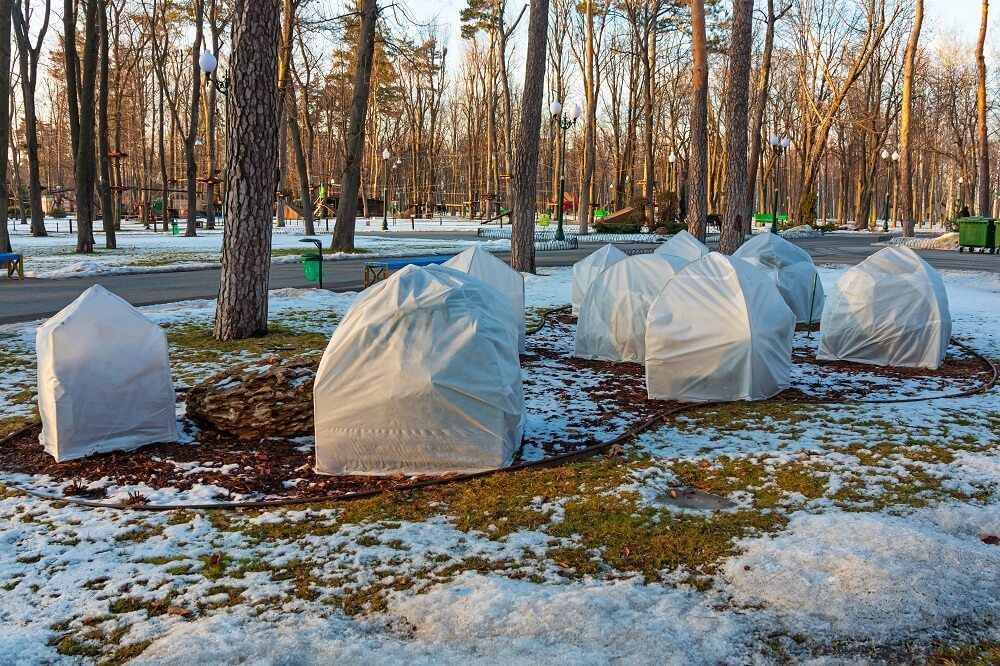
There are different types of agro-textiles on the market, which have different uses. Some are better at protecting against weeds and others against the cold. So what will be the best agro-textile for winter? A key feature of a good winter agro-textile is its grammage, i.e. the density of the material. In the event of frost, a 50–70 g/m² agro-woven fabric is recommended, which provides solid protection thanks to its greater thickness. Such a material insulates the plants perfectly from the cold air and at the same time allows moisture to pass through, preventing the plants from drying out. In addition, the colour of the agro-textile should be taken into account. Black, green and white are available, and it is the latter that will work well for protection against the cold.
Agro-textiles are usually available in rolls or sheets of different sizes, allowing the product to be tailored to specific needs. The variety allows you to choose the optimal protection depending on the type of plants and weather conditions. Remember to cover the plants tightly, protecting the edges from the wind. In this way, a properly selected frost protection agro-textile will effectively protect the plants, supporting their survival in harsh winter conditions.
One of the most frequently asked questions among gardeners is or agro-textile really protects against frost? Agrofiber is made of a material that creates a thermal barrier, thus reducing the direct impact of cold air on the plants. It acts as an insulator, trapping the heat of the ground, which helps to maintain a constant, higher temperature around the plants. Secondly, the nonwoven fabric allows moisture to penetrate, preventing the plant from drying out, which is important in winter when access to water is limited. Thanks to these properties, the agro-textile reinforces the plants’ natural defences, confirming that it is extremely useful during the winter months.
To agro-fibre could effectively protect from frost, it must be applied correctly. First of all, choose a suitable agro-textile with a recommended weight of 50–70 g/m². Start by covering the plant thoroughly, making sure it falls all the way to the ground. Make sure the plants are completely surrounded by the material to make the most of its insulating properties. Then fix the material to prevent it from moving in the wind — use special gardening pins, stones or string to secure the edges. It is important to spread the agro-textile evenly, avoiding unnecessary pressure on the plants that could damage them. Remember to regularly check the condition of the plants and the fixing of the agro-textile, especially after strong winds or snowfall. This will ensure that young seedlings and cold-sensitive plants are effectively protected from frost. Proper use of the agro-textile ensures that it will act as the best thermal barrier.
Use of agro-textiles for frost protection brings a number of benefits that decisively improve the condition of plants during the winter period. First of all, the agro-textile protects the plants from extreme temperatures and frosts, which increases their chances of surviving until spring. By stabilising the microclimate around the plants, the agro-textile helps to protect young and tender seedlings, leading to longer plant life and better yields in the coming seasons. Thanks to its insulating properties, plants are less exposed to heat stress, which strengthens their natural defence mechanisms.
Another advantage of using agro-textiles for frost protection is to save time for the gardener. Once correctly fixed, agro-textile requires minimal maintenance throughout the winter, reducing gardening activity in harsh weather conditions. By choosing the right agro-textile, suited to the prevailing climatic conditions, gardeners can enjoy the reassurance that their plants are effectively protected.
During application agro-textiles for frost protection gardeners often make several common mistakes that can negate its effectiveness. The first is choosing the wrong type or weight. A fleece that is too thin will not provide adequate insulation, so it is important to check which agro fleece for winter is appropriate — a weight of 50–70 g/m² is recommended. Another mistake is to cover the plants carelessly. The nonwoven fabric should surround the plants tightly and the edges must be firmly fastened. It is also a mistake to lay the agro-textile too tightly. Excessive pressure on the plants can damage them. In addition, a loosely imposed nonwoven fabric creates an ‘air bubble’ around the plant, thus protecting the plants more effectively.